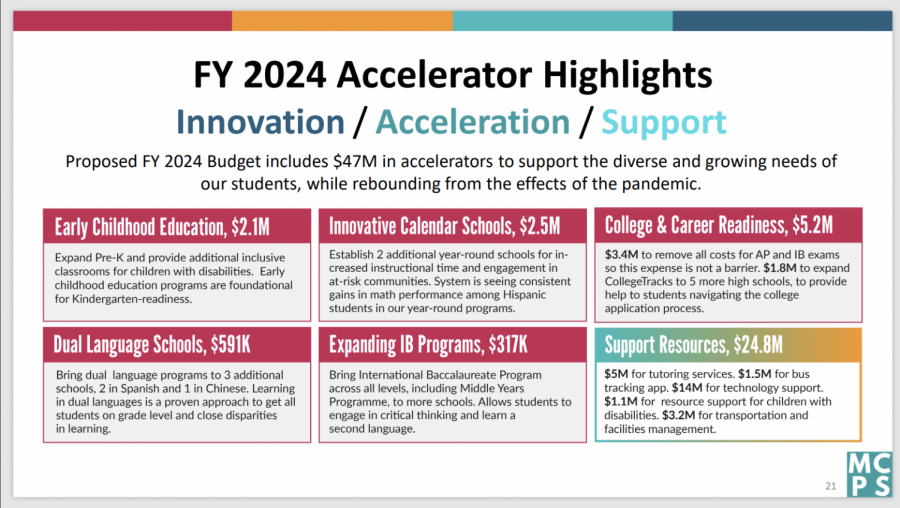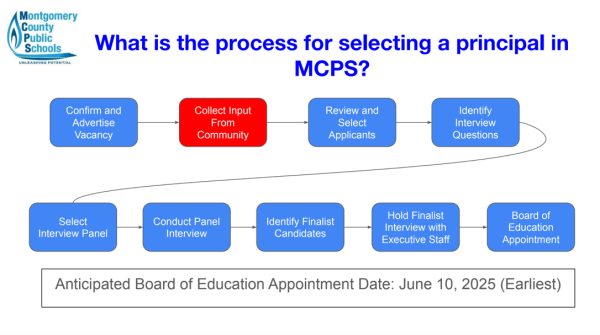District leadership analyzes student performance data, considers where to provide additional support, at MCPS press briefing
The proposed budget for Montgomery County Public Schools focuses on innovation, acceleration and support.
MCPS district leadership came together on Jan. 23 to analyze student performance data and discuss next steps to ensure students are learning at the highest levels.
The MCPS Press Briefing’s purpose was to reflect on student performance and see how MCPS can improve and where they can provide additional support. “The main question is are our students learning, are they learning enough? If not, then why not and what are we going to do about it?” MCPS Superintendent Monfia McKnight said.
Deputy Superintendent Dr. Patrick Murphy presented information on student enrollment, elementary literacy, middle school mathematics and high school and college career readiness. Murphy reported a total of 160,554 students enrolled in MCPS Pre-K through 12th grade. Student enrollment is still down from its peak in 2019 but there is an increase of over 2,300 students since the previous year, as well as an increase in Hispanic and Latino students. ““We see that as a positive sign. Our community is returning to our public schools, they believe in what we’re doing,” Dr. Murphy said.
Third grade literacy rates were also reported by Murphy, which is based off of the MAP assessment. Each student is assigned a lexile score, which is judged off of two measures: the level of the text and the reader’s ability to understand the text. A lexile score of 520 or higher indicates that students are on the right track. In the past three years there has been a decline in lexile scores dropping from 72.1% of students meeting bench mark in 2019 to 66.6% in 2022. Murphy did not sound discouraged, noting MCPS believes scores are beginning to stabilize, highlighting the .4% increase from 2021 to 2022.
Middle school math performance was discussed, despite having no data after 2019. In 2019 MCPS outperformed the state in Algebra 1 and Geometry but underperformed in Math 8. MCPS is waiting for performance data from 2022 to be released to see how students compare to the state and 2019 averages.
Murphy reported that more MCPS students are getting on track to graduate. 84.2% of ninth grade students are on track for graduation, a 2.5% increase seen in 2022. Specifically a 4.7% increase for Hispanic/Latino students, 4.4% increase for African-Americans, 3.6% increase for two or more races and 9% increase for students who receive free and reduced lunch. Although the state is requiring that all counties implement a ninth grade tracking system, “I’m happy to tell you that MCPS already has a system in place and we are going to continue to build and enhance upon that. And that is to ensure that all our ninth graders are on track for graduation,” Murphy said.
The four-year graduation rate has also increased, at 91.1% in 2022, with key gains for African-American and Hispanic/Latino students. Additionally, after the class of 2022 graduated high school, 6,106 of them immediately accessed college.
MCPS leadership also noted that students are increasing their participation in Advanced Placement (AP) assessments. In 2020 and 2021 there was a decline in AP course participation in MCPS but that trend is changing as 1,541 more AP exams were taken in 2022 than the year prior. The biggest increase was seen in students receiving free and reduced lunch, taking over 1,300 AP exams in 2022. The performance on AP exams has also increased, with 72.4% of MCPS students passing their exams this year.
The proposed FY 2024 budget is intended to provide support where the data presented shows investment is most needed. This includes an overall 8% increase in spending, making investments at every level. The major investments proposed are $2.1 million in early childhood education, $2.5 million in innovative calendar schools, $24.8 million in support resources and $5.2 million in college and career readiness. “At every level we have made investments in programs that specifically target our students and more importantly their needs,” McKnight said.
Your donation will support the student journalists of Thomas S. Wootton High School. Your contribution will allow us to purchase equipment and cover our annual website hosting costs.
Elizabeth is a 2024 graduate.







